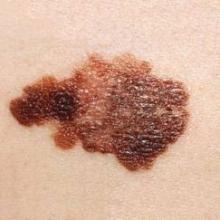People diagnosed with melanoma were significantly more likely to have melanoma in situ and to have thinner invasive melanomas if they had a regular dermatologist, compared with those who did not have a regular dermatologist, in a retrospective study of 388 patients diagnosed at an academic dermatology department.
These findings were statistically significant for those who had detected the melanomas themselves, but not for those whose dermatologists had detected the melanomas. Self-detected melanomas were in situ in 36 of 61 (59.0%) patients with an established dermatologist vs. 40 of 108 (37.0%) patients without an established dermatologist (P =.006), reported Michelle Cheng and her associates at the University of Pittsburgh.
The time needed to wait to see a dermatologist and the time since the last dermatologic examination were not associated with the invasiveness or the depth of the melanomas at the time of the diagnosis, the investigators said.
These findings "may be explained by a high benefit associated with a first dermatologic visit because of patient education about melanoma detection and/or having a dermatologist to call when the patient finds a suspicious lesion," they wrote (J. Am. Acad. Dermatol. 2014 March [doi:10.1016/j.jaad.2013.10.060]).
The study addressed the uncertainties about the impact of different factors on the invasiveness and depth of melanoma: having had a previous physical exam by a dermatologist before the diagnosis, the recency of that exam, and the time needed to wait for an appointment. The 388 adults (mean age, 55 years) were diagnosed with melanoma at the University of Pittsburgh Medical Center between February 2003 and December 2010. Of these patients, 51% had detected the melanoma themselves and 37% had had a dermatologic exam within the previous year at the university. Of the 388 melanomas diagnosed, 44% (171) were invasive with a mean Breslow depth of 0.96 mm. About 18% (71 patients), had a history of melanoma, and about 37% had seen a dermatologist within the previous year.
Of the 317 with no previous history of melanoma, almost 64% (103 of 162) of those with an established dermatologist were diagnosed with melanoma in situ vs. 44.5% (69 of 155) of those without an established dermatologist, a statistically significant difference (P = .001). The depths of the lesions were also significantly lower among those with an established dermatologist than among those with no dermatologist (median depth, 0.48 mm vs. 0.61 mm, respectively; P = .003).
Among the patients with self-detected melanoma, 41% of those with an established dermatologist had invasive disease, vs. 63% of those who did not have an established dermatologist (P = .006). But among the patients whose melanomas were detected by the dermatologist, 31% of those with an established dermatologist had invasive disease, vs. 40% of those with no established dermatologist, which was not statistically significant (P = .323).
When considering that a skin cancer screen is cost effective, the authors concluded, the results of this study "highlight the value of having even a single dermatologic examination and suggest that educating patients to detect their own melanomas is an important part of improving early detection of melanoma."
All of the patients were from one part of Pennsylvania and were treated at the same medical center, which was a limitation of the study, but the patients were heterogenous and were treated at four dermatology clinics by different attending dermatologists, the authors said. They could not confirm that each patient received the same level of education about melanoma at their visits, but added that most of the dermatologists in the clinics teach the ABCDEs of melanoma and provide counseling in skin self-exams and AAD skin cancer brochures.
The study included clinical research fellowship funding from the Doris Duke Charitable Foundation for one of the authors, UL1/NIH funding for another author, and funding for the statistics consultation from the National Institutes of Health. The authors declared no conflicts of interest.


